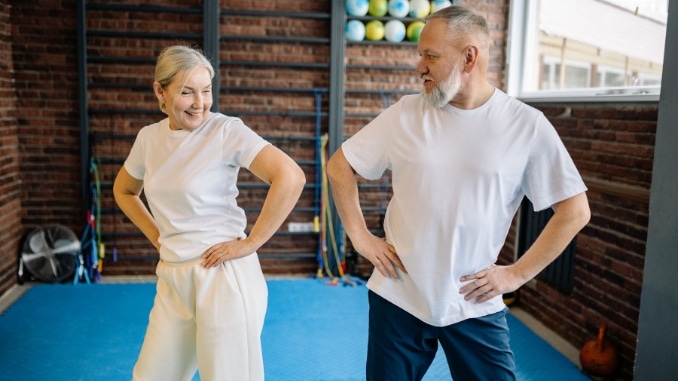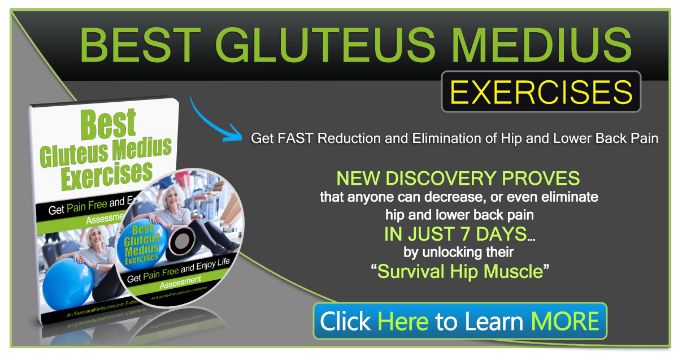If you’ve been struggling with stiff hips, aching joints, or limited mobility, you’re not alone. Hip pain affects [1] thousands of seniors, making everyday movements like walking, standing, or getting out of a chair feel like a challenge. I hope you had a great weekend.
But here’s the good news: there are simple, safe, and effective hip pain exercises for seniors that can help restore strength, increase flexibility, and get you back to doing what you love—pain-free.
Whether you’re dealing with hip and knee pain [2], recovering from recent hip surgery, or simply want to improve balance and mobility, these gentle movements can activate your supporting muscles, improve blood flow, and relieve tension in the hips, knees, and lower back.
1. Quarter Squat Exercise
- Stand with feet shoulder-width apart and extend your hands forward for balance.
- Slowly bend your knees and hips into a quarter squat. Keep your body straight, core tight, and hips square.
- Make sure your feet are flat on the floor and your knees track over your toes.
Tip: This exercise primarily strengthens the quadriceps, glutes, and hip extensors, while also improving knee stability and balance
Reps: 1 set of 5 reps in a smooth, controlled motion.
2. Wall Push-Up
- Lean forward slightly on your toes and slowly bend your elbows to bring your torso forward.
- Push back to the starting position.
Why it works: This variation gently engages the core, shoulder muscles, and even the hips through stabilization, which supports those with rheumatoid arthritis or recovering from surgery.
Reps: 1 set of 5 reps.
3. Wall Plank With Leg Kicks
- Place forearms against a wall at a 45-degree angle from standing.
- Tighten your abdominal muscles and slowly lift one leg straight back, then switch legs.
- Alternate kicking each leg while keeping the hips steady.
Why it’s great: This improves hip mobility, challenges hip abductors and hip flexor muscles, and supports balance. It also targets the hip extensor muscles and hip joint stability.
Reps: 1 set of 5 reps on each leg (10 total).
4. Bent-Over Row With Pressing Movement
- Stand with feet shoulder-width apart and knees bent.
- Hinge forward at the hips with your torso facing downward.
- Perform a row by pulling your arms back, then press upward in a slow and controlled motion.
Benefits: This exercise strengthens hip extensor muscles, core stability, glute muscles, and mid-back posture. It’s excellent for posture correction and helps reduce hip and knee pain.
Reps: 1 set of 5 reps.
5. Floor Bridge
- Lie flat on your back with knees bent, feet flat, and hands at your sides.
- Push through your heels to lift your hips until your knees, hips, and shoulders form a straight line.
- Hold for a few seconds, then gently lower your hips back down.
Pro tip: If you have difficulty getting down to the floor, try doing this on a firm bed.
Target Areas: Hip extensors, hamstrings, and glutes—perfect for seniors recovering from recent hip surgery or experiencing hip pain from prolonged sitting.
Reps: 1 set of 5 reps, focusing on control and a gentle pause at the top.
Why Are Hip Stretches Important for Seniors?
As we age, hip flexibility naturally decreases, and the supporting muscles around the hip joint become weaker. This makes seniors more susceptible to hip and knee pain, limited hip flexion, and falls.
Hip Stretches and Strengthening Exercises Help:
- Maintain mobility and independence
- Reduce pressure on the sciatic nerve [3]
- Increase blood flow and circulation
- Support recovery from hip injuries or surgeries
- Prevent joint stiffness and muscle atrophy
According to Dr. David Nolan, PT, DPT, MS – Massachusetts General Hospital & Harvard Medical School, “As we age, the muscles around the hip—particularly the gluteal and core muscles—tend to weaken, while flexibility decreases. Regular hip strengthening and stretching exercises can improve balance, prevent falls, and significantly reduce hip and knee pain in older adults.”
How Often Should You Do Hip Stretches?

For best results, seniors should aim to do these hip pain exercises at least 3–5 times per week. Start slow and focus on proper form. You can increase frequency as your strength and flexibility improve. Always consult your physical therapist or healthcare professional before beginning any new routine, especially if you’ve had surgery or are experiencing severe pain.
Bonus Tips for Better Results
- Use a resistance band for added challenge during standing hip flexor and abduction exercises.
- Hold onto a sturdy object for balance during standing hip extension movements.
- Perform hip marches while seated for added variety.
- Always warm up before stretching and cool down gently.
Struggling with tight hips, instability, or limited movement? These exercises are among the best exercises for seniors to safely improve hip strength, flexibility, and confidence, without causing pain.
Conclusion: Move Freely Again—One Step at a Time
Hip pain doesn’t have to define your golden years. With the right combination of hip pain exercises for seniors, you can regain control over your mobility, reduce discomfort, and feel stronger with each passing day.
Whether you’re recovering from recent hip surgery, dealing with tight hip flexors, or just want to keep your hips and knees pain-free, these low-impact exercises are a powerful, safe place to start. The key is consistency and listening to your body.
Start small. Stay committed. And don’t hesitate to reach out to a healthcare professional or physical therapist for guidance if you’re unsure. Your hips are your foundation—take care of them, and they’ll take care of you.
If you want to overcome or prevent back and lower body injuries, click here to check out the Best Gluteus Medius Exercises Program!
Frequently Asked Questions
What causes hip pain in seniors?
Hip pain in seniors is often caused by age-related wear and tear on the hip joint, arthritis (like osteoarthritis or rheumatoid arthritis), decreased hip flexor strength, or previous injuries. Weak glutes, tight hip flexors, or lack of movement can also lead to discomfort in the hips, knees, and lower back.
Can seniors do hip exercises after recent hip surgery?
Yes, but it’s crucial to follow a physical therapist’s guidance. Many of the exercises listed here—like bridges, standing hip extensions, and wall-supported movements—are gentle enough to be part of early post-surgery rehab. Always get medical clearance before starting.
How long does it take for hip pain exercises to work?
With consistent effort (3–5 times per week), most seniors begin feeling improvements in mobility and reduced hip pain within 2 to 4 weeks. However, progress varies depending on the severity of the condition and individual fitness level.


